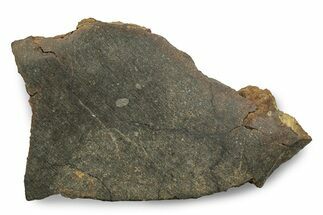This Specimen has been sold.
.85" Chelyabinsk Chondrite Meteorite (5.9 g) - Russia
This is a .85" wide (5.9 gram) stony (chondrite) meteorite from the observed fall over Southwest Russia. It's an LL5 chondrite composed of a light-colored lithology with a typical chondritic texture.
The Chelyabinsk Meteorite - 2013 Witnessed Fall
On February 15th, 2013 at 9:22 a.m. local time, a tremendous fireball lit up the sky over the city of Chelyabinsk in southwest Russia. Shortly afterwards, a massive shockwave reported to be equivalent to a 300 kiloton explosion rocked the area. Windows were blown out in thousands of buildings and nearly 1,000 people were injured, primarily from flying glass. Some residents reportedly thought nuclear war and begun and the world was about to end.
The cause of this destruction was a meteor estimated 55 feet wide that had entered Earth's atmosphere before exploding 18 miles above the surface. This is believed to be the largest meteor to enter our atmosphere since the Tunguska meteor more than a century earlier.
Most of the meteor vaporized during the airburst, but thousands of small stones, most only weighing a few grams, rained down around several villages about 40 kilometers Southwest of Chelyabinsk. The meteorite stones and fragments ranged from less than a gram to 1.8 kilograms in weight. The total mass collected by local people is estimated to be between 100kg and 1000kg. Most of these stones have a black or brown fusion crust.
Meteoritical Bulletin: Entry for the Chelyabinsk Meteorite
On February 15th, 2013 at 9:22 a.m. local time, a tremendous fireball lit up the sky over the city of Chelyabinsk in southwest Russia. Shortly afterwards, a massive shockwave reported to be equivalent to a 300 kiloton explosion rocked the area. Windows were blown out in thousands of buildings and nearly 1,000 people were injured, primarily from flying glass. Some residents reportedly thought nuclear war and begun and the world was about to end.
The cause of this destruction was a meteor estimated 55 feet wide that had entered Earth's atmosphere before exploding 18 miles above the surface. This is believed to be the largest meteor to enter our atmosphere since the Tunguska meteor more than a century earlier.
Most of the meteor vaporized during the airburst, but thousands of small stones, most only weighing a few grams, rained down around several villages about 40 kilometers Southwest of Chelyabinsk. The meteorite stones and fragments ranged from less than a gram to 1.8 kilograms in weight. The total mass collected by local people is estimated to be between 100kg and 1000kg. Most of these stones have a black or brown fusion crust.
Meteoritical Bulletin: Entry for the Chelyabinsk Meteorite
TYPE
Ordinary Chondrite (LL5)
LOCATION
Chelyabinskaya Oblast, Russia
SIZE
.85 x .65 x .4", 5.9 grams
CATEGORY
SUB CATEGORY
ITEM
#247007
 Reviews
Reviews












